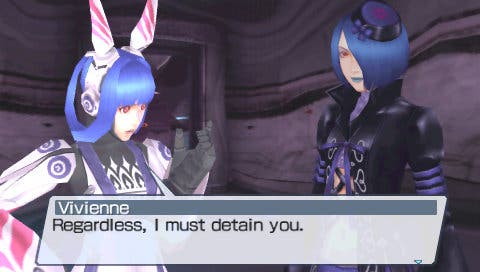Phantasy Star Portable
PSP PSP.
There are two ways around the problem, neither of which are as effective as playing the game how the developer intended, with friends sat together in close proximity. Firstly, the forthcoming functionality that will allow online multiplayer games to be played via infrastructure mode through the PlayStation 3 will solve the problem (although at time of writing we were unable to test how well this works). Secondly, for the single-player it's possible to augment your team with three A.I.-controlled players, teammates who provide back up and healing to your character.
This is a welcome addition but, with atrocious path-finding (which creates real frustration when negotiating certain winding-corridor areas of the game world) and poor decision-making when it comes to healing and reviving fallen comrades, the feature falls far short of the ideal. While it's still preferable to take CPU-controlled teammates into battle with you rather than going it alone, your team is nevertheless burdensome, often at times when you have enough difficulties to contend with without their without their failings exacerbating your problems.
Other obvious concessions to the handheld format may put off PSU veterans. The world hub is now rendered as a 2D overhead map, while the NPC characters that you can interact with in these areas are now shown as static portraits, stills of the 3D models. Gone is the customisable aspect to your space station apartment, as is the item-feeding evolution system for your 'Partner Machinery' (PSU's version of MAGs), which is replaced by straightforward upgrades that customise your virtual combat pet's behaviour during battle.
But sometimes less is more and these features of the fully-fledged PSU did not make up its primary appeal. Instead, Phantasy Star Portable's reduction acts as a streamlining, reducing the amount of time it takes to explore the inter-battle world, making key NPCs quicker and easier to find, dropping load times to acceptable levels and removing much of the deadweight that clogged its immediate forebear.

What's left then is a snappy action-RPG with a huge amount of quest content, a diverse range of environments and enemy types and a selection of lead character types each with huge and engaging development trees (from Hunter to Fightmaster to Acromaster, for example): all the ingredients that made PSO such a compelling proposition and then some. This is a game for players who love to collect, who find thrill in the unpredictability of item drops, and pleasure in customising the minutiae of a character's appearance in order to show off to fellow players.
It's more accessible to Westerners than that other Japanese item collect-'em-up Monster Hunter, yet still deep and wide enough to warrant tens of hours worth of investment. The combat is fast-paced and often enjoyable, encouraging careful timing of inputs to build up powerful combo hits, and the game's solid strength in this area helps to paper over its obvious shortcomings in storytelling (which has always been a series weakness).
Judged in isolation as a PSP title, Phantasy Star Portable offers recurring glimpses of the unforgettable RPG multiplayer baby steps we first experienced with Phantasy Star Online on SEGA's Dreamcast. But today, with a wealth of multiplayer action-RPGs on the market for other systems, most of which are far easier to set up for multiplayer sessions, only committed players will have the tenacity to get the most from the game. For that reason, it's destined to remain a niche product in Europe, even if, for those who do fall for it, its depths as a handheld multiplayer RPG ensure it may never be forgotten.
